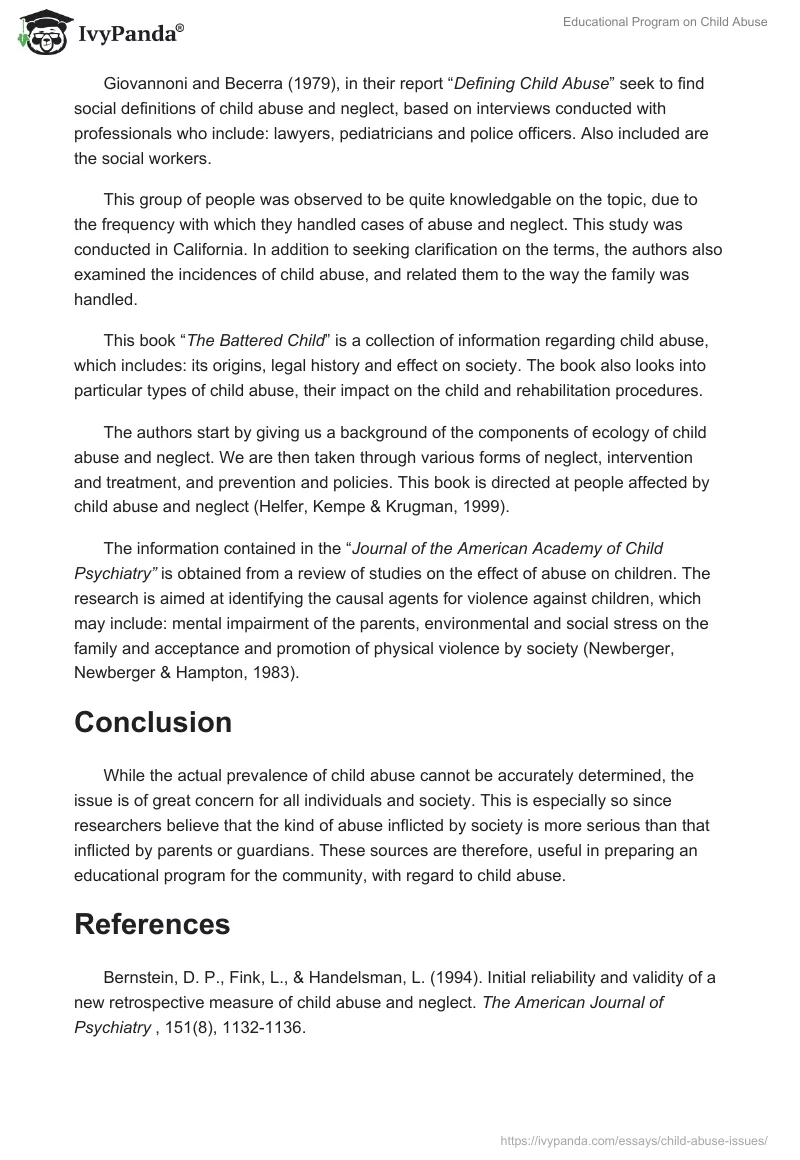Child abuse is an act where the rights of a child are violated for a particular reason. Child abuse ranges from several acts which can be summarised as: denial of the right to education; denial of the right to basic necessities; Inflicting pain by form of beating or any other type that can be considered molestation; rape and other sexual forms of harassment; and child labour. The following references would be useful when coming up with an educational program for sensitizing the community on child abuse.
Reports and reference materials
The report “Initial reliability and validity of a new retrospective measure of child abuse and neglect” by Bernstein, Fink and Handelsman (1994) provides the findings of the consistency and validity of some of the conservative measures of child abuse and neglect, by analyzing the responses from administering a questionnaire.
The test was conducted on patients who were dependent on either alcohol or drugs, and a re-test followed after a period of about four months. From the questionnaires, it was deduced that child abuse and neglect constituted four factors namely: physical neglect, sexual abuse, amotional neglect, and physical and emotional abuse.
In the book “Violence Against Children – Physical Child Abuse in The United States”, Gil (1973) provides some useful facts acquired after the careful examination of various studies conducted on child abuse. The author looks into public awareness, attitudes and opinions, in order to evaluate the scope of child abuse in the United States.
Information used by Gil in his analysis is obtained from incidents of physical abuse reported via legal channels that are evident from statistics on juvenile courts, child care facilities, correctional institutions, abuse in schools and infant mortality, among others. The author looks at the prevalence of child abuse practices based on education level, strength of family, number of children in the family and the socioeconomic strata of society.
Giovannoni and Becerra (1979), in their report “Defining Child Abuse” seek to find social definitions of child abuse and neglect, based on interviews conducted with professionals who include: lawyers, pediatricians and police officers. Also included are the social workers.
This group of people was observed to be quite knowledgable on the topic, due to the frequency with which they handled cases of abuse and neglect. This study was conducted in California. In addition to seeking clarification on the terms, the authors also examined the incidences of child abuse, and related them to the way the family was handled.
This book “The Battered Child” is a collection of information regarding child abuse, which includes: its origins, legal history and effect on society. The book also looks into particular types of child abuse, their impact on the child and rehabilitation procedures.
The authors start by giving us a background of the components of ecology of child abuse and neglect. We are then taken through various forms of neglect, intervention and treatment, and prevention and policies. This book is directed at people affected by child abuse and neglect (Helfer, Kempe & Krugman, 1999).
The information contained in the “Journal of the American Academy of Child Psychiatry” is obtained from a review of studies on the effect of abuse on children. The research is aimed at identifying the causal agents for violence against children, which may include: mental impairment of the parents, environmental and social stress on the family and acceptance and promotion of physical violence by society (Newberger, Newberger & Hampton, 1983).
Conclusion
While the actual prevalence of child abuse cannot be accurately determined, the issue is of great concern for all individuals and society. This is especially so since researchers believe that the kind of abuse inflicted by society is more serious than that inflicted by parents or guardians. These sources are therefore, useful in preparing an educational program for the community, with regard to child abuse.
References
Bernstein, D. P., Fink, L., & Handelsman, L. (1994). Initial reliability and validity of a new retrospective measure of child abuse and neglect. The American Journal of Psychiatry , 151(8), 1132-1136.
GIL, D. G. (1973). Violence Against Children – Physical Child Abuse in The United States. Cambridge, MA: Harvard University Press.
Giovannoni, J. M., & Becerra, R. M. (1979). Defining Child Abuse. Third Avenue, New York: The Free Press.
Helfer, M. E., Kempe, R. S., & Krugman, R. D. (1999). The Battered Child. Chicago: University Of Chicago Press.
Newberger, E. H., Newberger, C. M., & Hampton, R. (1983). Child Abuse: The Current Theory Base and Future Research Needs. Journal of the American Academy of Child Psychiatry , 22(3), 262-268.


